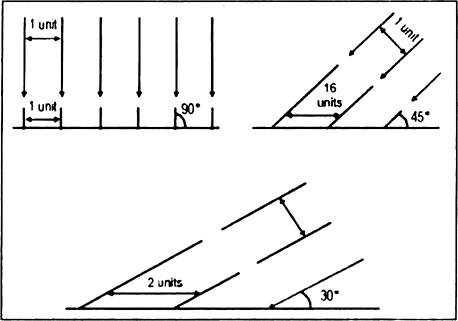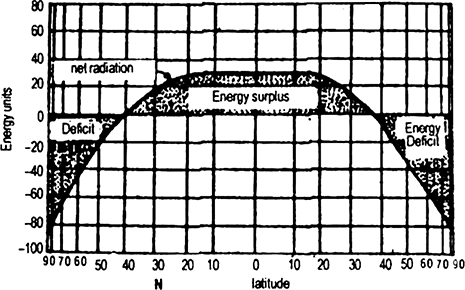Fundamental Of Physical Geography Chapter 9 Solar Radiation, Heat Balance And Temperature
Sponsor Area
NCERT Solution For Class 11 Geography Fundamental Of Physical Geography
What is insolation ?
What are the ways in which the atmosphere is heated ?
The atmosphere gets heated in the following ways:
1. Radiation
2. Conduction
3. Convection
4. Advection
What are the isotherms ?
What part of heat energy radiated by the sun is intercepted by the earth ?
What do you mean by the annual range of temperature?
Why do isotherms bend while crossing the continents and oceans ?
Mention distance from the sea as a factors controlling temperature distribution.
i. Land heats up and cools down quickly. Therefore, the variation in temperature over the sea is less compared to land.
ii. The places situated near the sea come under the moderating influence of the sea and land breezes which moderate the temperature.
How altitude act a factor in temperature distributions?
i. The atmosphere is indirectly heated by terrestrial radiation from below. Therefore, the places near the sea-level record higher temperature than the places situated at higher elevations.
ii. In other words, the temperature generally decreases with increasing height.
iii. The rate of decrease of temperature with height is termed as the normal lapse rate. It is 6.5°C per 1,000 m.
Why do different parallels receive different amounts of insolation ?
What is the inversion of temperature? Why does inversion of temperature occur in winter night?
Inversion of temperature takes place in calm, cold and clear winter night because the earth's surface cools more rapidly in such nights.
How do clouds affect the temperature of a place ?
How does the unequal distribution of heat over the planet earth in space and time cause variations in weather and climate ?
Why is the annual range of temperature high in the Siberian plains?
What are the factors that control temperature distribution on the surface of the earth?
The factors controlling the temperature distribution on the surface of the earth are mentioned below:
1. The latitude of the place
2. Altitude of the place
3. Distance from the sea
4. Ocean currents
5. Local aspects
How does angle of the sun's rays falling on the ground affect the amount of insolation? Describe with an appropriate diagram.
i. When the sun is overhead its rays are nearly vertical over the surface and are more concentrated. Hence, the intensity of insolation is more. If the angle of incidence is low, rays are oblique. Therefore its spreadout is more and the intensity of insolation less.

Inclination of the sun rays
ii. The sun's rays striking the earth at a small angle of inclination traverse more of atmosphere than rays striking at a high angle.
Longer the path, greater the amount of scattering, reflection and absorption by the atmosphere which reduces the intensity of insolation at the surface. At sunrise the angle of incidence of sun's rays is low. Hence solar energy received is low. At noon, the angle of incidence is highest and so the solar energy received is high.
During evening again the angle of incidence becomes lower than at noon and the solar energy received is low. Hence, the solar energy received on the surface of the earth is directly related with the angle of incidence of the rays of the sun.
Explain the latitudinal heat balance.
This is primarily due to the spherical shape of the earth and the revolution of the earth around the sun on its inclined axis. The amount of insolation gradually decreases from the equator towards the poles. Similarly the amount of terrestrial radiation also varies. At latitudes below 40 degrees or more the solar radiation received than is lost to space by the earth. Beyond the 40° latitudes more heat is lost than received.

Latitudinal Heat Balance
The area between 40° north and south latitudes should have been getting progressively hotter and the area from 40° latitude to the poles getting cooler progressively. But this is not so.
The atmosphere and ocean act against thermal energy that transfer heat from the tropics towards the poles. Due to imbalance of heat, winds and ocean currents are produced. This transfer of heat energy from the surplus zones to deficit zones maintains an overall balance over earth's surface.
Sponsor Area
In India, why is the day temperature maximum in May and why not after the summer solstice
Define terrestrial radiation.
State the characteristics of isotherms.
The characteristics of isotherms are stated below:
1. Isotherms run along the latitudes, but they are not parallel to the latitudes.
2. They take sudden bends at land-water edges because of land-water contact.
3. They are drawn at equal spaces which indicate the latitudinal thermal gradient.
4. Isotherms change their positions.
5. In summer isotherms passing over the sea bend towards the equator but in winter they turn away from the equator.
Mention the conditions favourable for the inversion of temperature.
1. Long nights: During the winter, long nights are favourable for making the surface cold due to rapid outgoing radiation.
2. Clear sky: Under the clear sky the loss of heat by radiation is rapid and unchecked.
3. Calm air: During the calm weather, no air movement is in the atmosphere.
4. Dry air: The dry air does not absorb heat radiation and favours inversion of temperature.
5. Snow covered surface: The frozen surface is a poor conductor of heat and checks the upward flow of heat from the ground.
State the climatic significance of inversion of temperature.
The climatic significances are:
1. It checks the process of convection and advection of air currents.
2. Dense fog occurs in the valley bottoms.
3. The upper layer of the air becomes dry.
4. Dense smog results beneath the inversion layer.
5. Stratus clouds are formed below the inversion layer.
What is advection ?
How does the atmosphere affect the incoming (to the earth) short wave solar radiation ? How is the atmosphere affected by the outgoing long wave radiation from the earth ?
Very small suspended particles in the troposphere scatter visible spectrum both to the space and towards the earth's surface. The red colour of the rising and setting sun and the blue colour of the sky are the result of scattering of light within the atmosphere.
The long wave radiation from the earth is absorbed by the atmospheric gases particularly by the carbon dioxide and the other greenhouse gases. Thus the atmosphere is indirectly heated by these long wave radiations.
Analyse the factors that control the heat balance at 20°N latitude. Although at 20°North the heat balance is surplus even then why is this area not progressively heated up ?
Define daily mean temperature and monthly mean temperature.
Daily mean Temperature :

Monthly mean temperature : The average of the daily mean temperature of all days of a month is known as monthly mean temperature.
Monthly mean temperature of June.






